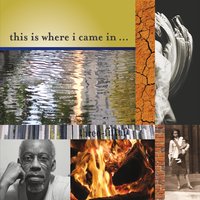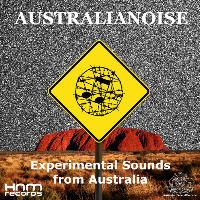|
Music Is The Healing Force Of The Universe The Inconsistency of |
|
|
||||||||||||||||
|
June 1 2017
The Fondation Maeght Film - again I haven’t mentioned the documentary film of Albert Ayler’s final concerts in France in July 1970 for a while, but it turned up in a couple of emails last month. When I first found out about the existence of the film, back in the early days of this site, I emailed the Fondation Maeght and was informed that the film could be viewed on their premises by appointment, so that’s the information that’s been on this site ever since. Turns out, circumstances have changed, so, sorry about that. Dirk Goedeking emailed the Fondation Maeght and made enquiries about the film, and it now seems you can’t make an appointment to see it, you have to wait until they decide to mount a public showing. The other email came from Alain Chauvat, who was actually at the Fondation Maeght concerts in 1970. He writes: “My first introduction to A. Ayler’s music was when I was fourteen in St Paul-de-Vence; I knew absolutely nothing about jazz. What a shock! In the course of two weeks I discovered Ayler, Sun Ra, Terry Riley, LaMonte Young, Stockhausen.... For Xmas 1970 I got my first Ayler LP: In Greenwich Village. I was lucky enough to have seen twice the movie made at St Paul-de-Vence, first in Paris during the Paris Jazz Festival in 1990 for the 20th celebration of the passing.... In fact due to a huge demand there were two showings of this movie that needs a new mix, because the sound and picture are not synchronised (the sound was about four seconds late...) and I saw it again in a festival -now defunct- in Le Mans in 1992 or 1993, also out of sync.” For a while now I have been meaning to gather all the stills from the film posted on the Merzbo-Derek blog and add them to this site - I have to thank ‘Merzbo-Derek’ for letting me do this - and I’ve finally got round to it. You’ll find the photos here: Stills from Albert Ayler: Le Dernier Concert I’ve not seen the film, so I have no idea whether the screenshots are in the right order, I doubt it. I just took the various blocks of photos from the Merzbo-Derek site and stuck them on here. If you want to make them into an animation, or even an old-fashioned flicker book, then you’ve got more time on your hands than I have, but here’s an unreleased track from the Fondation Maeght concert of 27th July, 1970, to accompany your endeavours: * More from France Alain Chauvat also sent me the following page from Jazz Magazine No. 125 from December 1965, which is interesting since it has a French version of the Albert Ayler article which later (much later, March 1967) appeared in the International Times. According to Alain: ‘JM sent a questionnaire to many jazzmen/women from the “new thing”; the exception was Albert Ayler, who did not answer question by question (out of 10) but instead sent a written text. This issue of Jazz Mag #125 also had interviews with Cecil Taylor, Sun Ra, Ornette, Archie Shepp, Karl Berger, Carla Bley, Paul Bley, Jean-Louis Chautemps, Bill Dixon, Don Ellis, Don Friedman, Jimmy Giuffre, Eddie Gomez, Milford Graves, Don Eckman, David Izenzon, Bob James, Steve Lacy, Giuseppi Logan, Jimmy Lyons, Mike Mantler, Steve Marcus, Sunny Murray, Gary Peacock, Barre Phillips, Roswell Rudd, John Tchicai, Charles Tyler, Bernard Vitet, Lewis Worrell.’ A pdf of the original French version is available here (it may appear upside down, sorry) and the English translation is in the Articles section of the Archives. * And yet more ... Looking around for more information about that issue of Jazz Magazine, I came across this: ‘Free Jazz and the French Critic’ The essay was published in the Journal of the American Musicological Society, Vol. 61 No. 3, Fall 2008 (pp. 541-581). I’ve not had time to read it yet, but I’m hoping it will explain the difference in the response of the French jazz critics to that of the English to Free Jazz. * At The Grave Of Albert Ayler Pierre Crépon let me know about this piece by bassist Jair-Rohm Wells.
|
|
And finally . . . Free At Last, The Astrology Of Albert Ayler And Beyond * What’s New January - May 2017 is now in the Archives. ***
July 1 2017
Don Ayler concert Richard Koloda has unearthed a recording of a Don Ayler concert at Cleveland State University from 3rd May, 1981. The Don Ayler Sextet (Don Ayler (c), Frank Doblekar (ts), Ed MacEachen (g), David Thomas (p), Kip Reed (b), Marty Barker (d)) perform three tunes, ‘The Be-Bop Song’, ‘The Eastern Tune’ and ‘Coltrane’s Blues’, then the Cleveland State University Jazz Ensemble play five more (with Don Ayler advertised as co-conductor). The concert took place about six weeks before Don’s trip to Italy and his concerts in Florence, so the music of the sextet is similar to that, although there is only one other musician in both groups - the tenor player, Frank Doblekar. This is an ad for the concert from the Cleveland Plain Dealer: |
 |
|
New Ghosts Staying in Cleveland, this is a short video from Cool Cleveland featuring Matt Laferty and Andy Auten from the New Ghosts group which keeps Albert Ayler’s legacy alive in his home town.
|
|
More from youtube I must thank Dirk Goedeking for letting me know about the above. Dirk also mentioned a lecture by Dr, François-Marc Gagnon on the subject of ‘The Human Figure in Canadian Art: Michael Snow’s “Walking Women”’, given at the Montreal Museum of Fine Arts on 16th June, 2004. According to Dirk, New York Eye And Ear Control gets a mention, but Albert doesn’t. And if that’s not esoteric enough for you, there is a French version. And here’s David Kettlewell playing his chromatic harmonica to Albert Ayler’s version of George Gershwin’s ‘Summertime’, in the dark, for some reason. Larry Adler, eat your heart out.
|
|
Guitar vs. Saxophone A battle I frequently have with my mate Clive, but now it seems we are embarking on a new period of peace and reconciliation, with ultimateGuitar.com featuring ‘Jazz Saxophone Virtuosos’. Albert makes the list, but, rather surprisingly, Coleman Hawkins doesn’t. * |
|
|
||||||||||||
|
And, finally, the Argentinian guitarist, Claudio Nuñez has a new download album featuring Ayler versions and tributes, described as “some extrapolations on ayler’s music with a little beefheart”. |
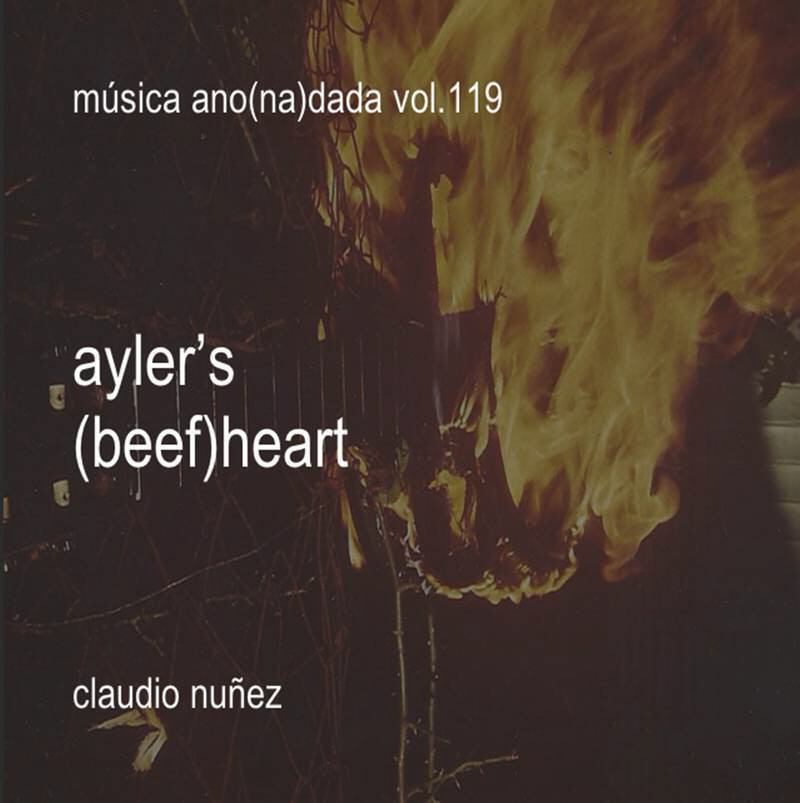 |
|
August 1 2017
New York Eye And Ear Control - the movie Thanks to Dirk Goedeking who has found a way to watch Michael Snow’s short film, New York Eye And Ear Control. It ain’t easy, and it ain’t cheap, but here’s how he did it. He emailed LUX, the U.K. distributors of the film, and received this reply: “Many thanks for your request. According to our records, New York Eye And Ear Control was shown in July last year at DIY Space for London, and before that at Kunstmuseum Stuttgart in October 2015. There are currently no planned screenings in the upcoming months. You can watch full length previews of a selection of works from the LUX Collection online via the LUX Private Preview Pages, including New York Eye And Ear Control by Michael Snow. Subscribing to the LUX Collection Preview pages will allow you 14 days’ access to a selection of videos from the LUX collection, and costs £20. Please go to: https://lux.org.uk/subscribe-preview-pages .” I had problems with finding the information on the LUX site, so you may need to email them first. Good luck! |
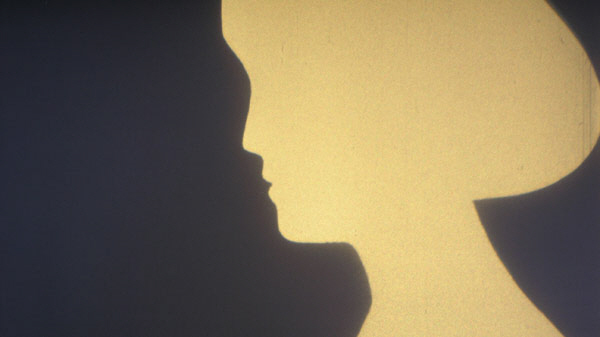 |
||||||
|
Dirk also gave me this description of the way the music is used in the film: ‘In the first third there is silence, only interrupted by “Don’s Dawn” when the Walking Woman appears. “ITT” is played throughout the rest of the film. The end is silent again. “AY” is not played at all. I’m sure Michael Snow was very consciously placing the picture to the music: the Walking Woman appears in the foreground for the first time exactly when Don Cherry reaches his final high tone. Interesting, but no music: few seconds after Ayler ends “ITT” with a fanfare theme, you can hear 4 seconds after-session-sounds: three bass notes and some voices.’ Coincidentally, New York Eye And Ear Control was recently shown at the Yerba Buena Center for the Arts in San Francisco as part of ‘Eye and Ear Control: ESP-Disk’ on Film’. Described as “A selection of short films on the evolution and formation of what came to be called free jazz through the form’s earliest adopting record label, ESP-Disk’”, the films featured were: New York Eye and Ear Control, (dir. Michael Snow, 1964, 34 min, 16mm) The event was curated by Brian Belovarac of Janus Films/The Criterion Collection, and took place on 20th to 23rd of July. * Rotterdam photos On the Amsterdam City Archive site, there are a series of photographs by Nico van der Stam (1925-2000), taken at the De Doelen concerts in Rotterdam in November, 1966. These are presented as ‘contact sheets’ (I should shut up now and stop pretending I know something about photography) - this is a screen grab of No. 28 (‘Jazz In De Doelen: Albert Ayler Quintet, Sonny Rollins Freddie Hubbard, Max Roach, De Doelen Rotterdam 08-11-1966’): |
||||||
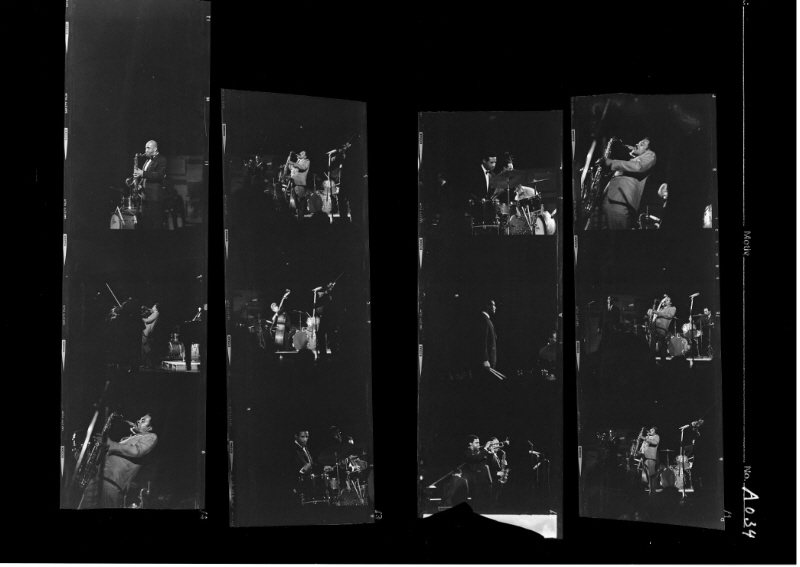 |
||||||
|
And this is No. 50 (‘Albert Ayler Quintet, Michael Samson, De Doelen Rotterdam 08-11-1966’): |
||||||
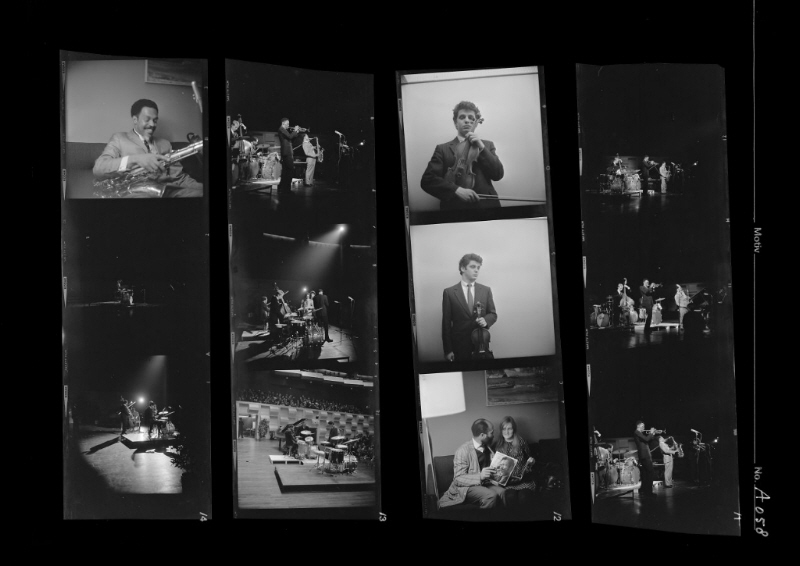 |
||||||
|
On the site, obviously, you can zoom in and see the individual photos. But that’s not all. The Albert Ayler group also appears in two more files: No. 32 (‘Sonny Rollins Trio Jazz In De Doelen Rotterdam 08-11-1966’) - the first sheet has a few Ayler shots (some upside down), the second one is mainly the Ayler group, including a couple of photos of someone trying to fix Beaver Harris’s drumkit to the stage. No. 92 (‘Jazz van de Doelen : Max Roach Quintet, De Doelen Rotterdam 08-11-1966’) - half of which is of the Ayler group. Some of the photographs also appear on the Maria Austria Institute site, including the one of the couple backstage, which is labelled, erroneously, as, "Jazz saxophonist Albert Ayler with wife, De Doelen Rotterdam, November 8, 1966". One final thing - there is, in the Music section of this site, an mp3 entitled, ‘The Rotterdam Tape’, which is the audio of a video clip of Ayler from the European tour, which was included in a TV programme about the state of jazz entitled ‘Jazz is niet dood’, broadcast in the Netherlands on 15th July 1970. Because the programme was shown in the Netherlands, there’s always been a theory that it was filmed at the November 8th concert at De Doelen, Rotterdam, despite it not conforming to the tracks released in the Holy Ghost box, and despite there being no evidence that the concert was recorded for TV. As a further piece of evidence, I would just like to point out that in all these photos from the concert, I have yet to spot a TV camera. * More photos On youtube there’s an item where the photographer, Philippe Gras (1942-2007), is describing one of the photos which he took during Albert Ayler’s final concerts in France. This particular photo is not from the Fondation Maeght, but was taken at the free concert which Ayler gave at the Village Vacances Tourisme, La Colle sur Loup, on 28th July, 1970. I have to thank Pierre Crépon for sending me a quick translation of Philippe Gras’ commentary.
|
||||||
|
The photo on youtube is cropped, so here’s the original: |
||||||
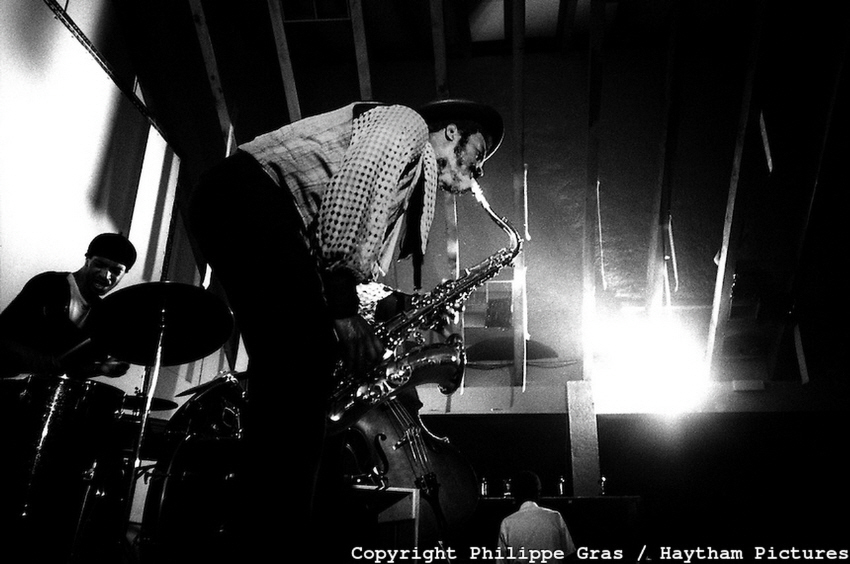 |
|
More photos of Albert Ayler are available on the site dedicated to the work of Philippe Gras. * Back to the Netherlands Thought I should mention a couple of things, although they’re both in Dutch. First, the Netherlands Jazz Archive has a section on their site called ‘Jazz Helden’ (‘Jazz Heroes’), which, dealing with the period 1966-1974 (‘Conflict en Vernieuwing’ - ‘Conflict and Renewal’), has a short video piece on Albert Ayler, featuring interviews with Pierre Courbois, Michiel de Ruyter, Herman de Wit and Willem Breuker. Second, Hans Dulfer, who met Albert Ayler when he was in the Netherlands in 1964, published the first part of his biography in January, last year. More details here. * And, staying in Europe ... I came across the following (pp. 126-132) in Joe Boyd’s 2006 memoir, White Bicycles, relating to the 1966 Newport in Europe tour: |
|||||||||||
 |
|||||||||||
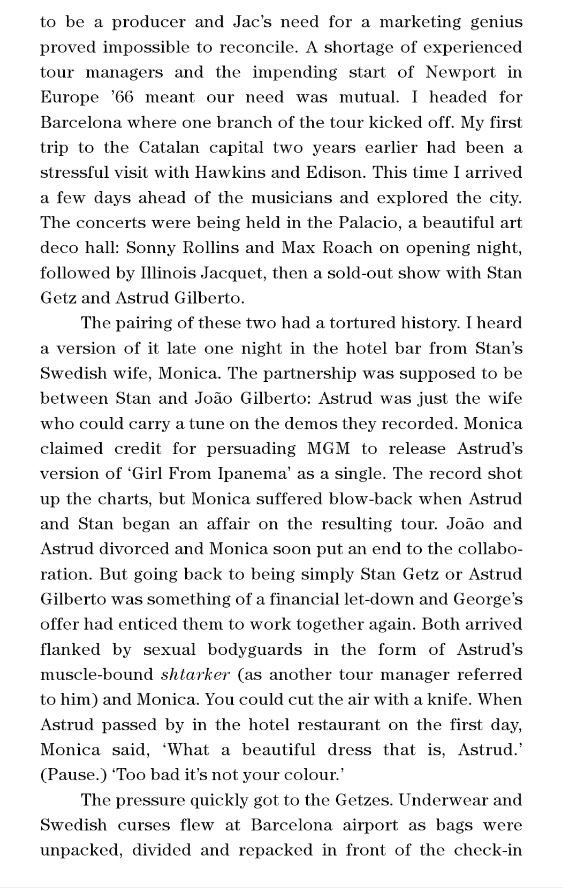 |
|||||||||||
 |
|||||||||||
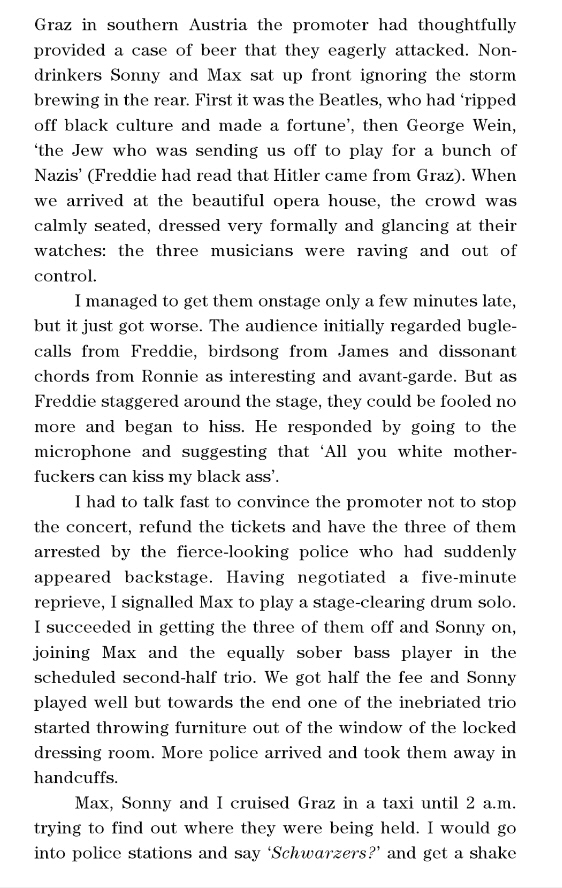 |
|||||||||||
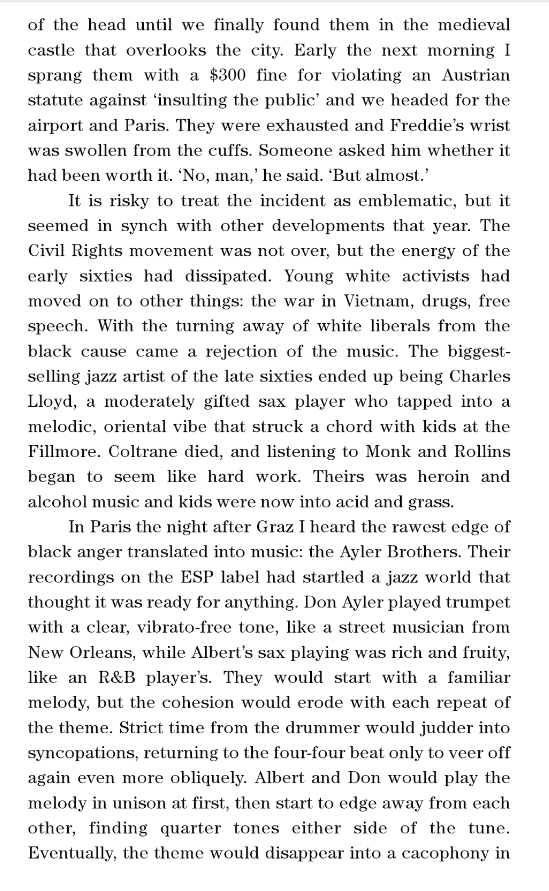 |
|||||||||||
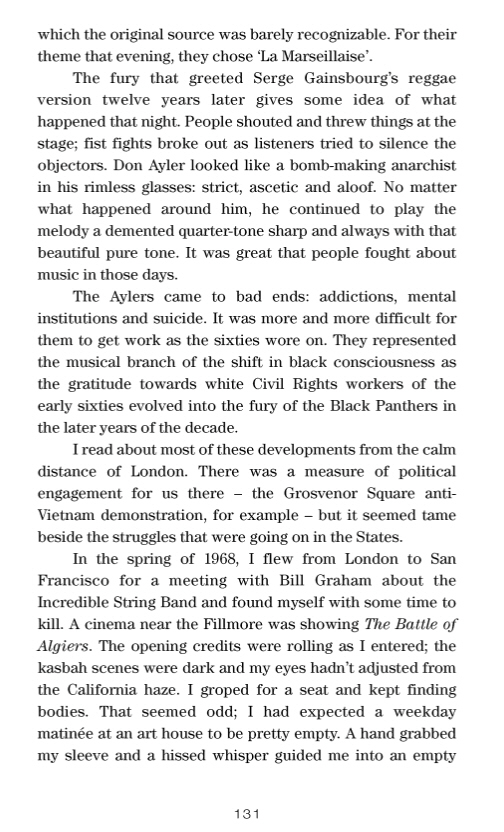 |
|||||||||||
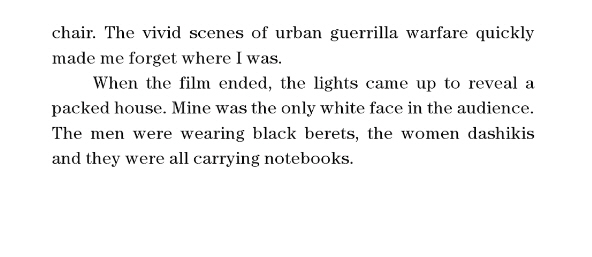 |
|||||||||||
|
And then there was London There’s another account of the L.S.E. concert on the Sandy Brown Jazz site, which I don’t think I’ve mentioned before . It’s by Robin Kidson and though more of an overview of what we already know, one new fact does emerge. Way back when, I contacted the BBC and asked if the videotape still existed - a long shot, but I thought I’d better check - and I got a nice reply saying there was no trace and so I left it at that. Robin Kidson went one better: ‘I recently wrote to the BBC’s Written Archives Centre to see if there was any formal record of the decision not to broadcast the Ayler LSE concert. The Centre wrote back having diligently looked through the relevant files but could not find anything – “editorial decisions of this kind were not uncommon”, they write, “and there’s no guarantee of being able to follow any paper trail”. They also looked to see if there were any contractual papers but, again, could not find any. They were “slightly surprised at this, since Ayler must have been paid, but there are often complications when it comes to records of payment to artists not resident in the UK”.’ There was a programme on BBC4, last year I think, where Penelope Keith was going through the BBC’s ‘Written Archives’. In the main it was all very jolly, as you’d expect, but when you consider the extent of the archive, the minutiae of ancient memos which have been carefully kept, it does make you wonder why anything to do with Albert Ayler’s 1966 concert seems to have been totally eradicated. Ooooh, grassy knoll. * Cricket and Jihad I put it like that to confuse GCHQ if they suddenly decide to take notice. Albert Ayler’s ‘essay’, ‘To Mr. Jones - I Had A Vision’, was published in the final issue of The Cricket sometime in 1969. Trying to pin down that date, I found this 2001 interview with Amiri Baraka about the magazine, first published in Hambone 21 (2015). No new information about the Ayler piece but there is this discussion about the Jihad record label which may be of interest: ‘Amiri Baraka: Yeah. There’s a lot of JIHAD stuff that’s never been put out. We’re getting ready to release some of that now. Christopher Funkhouser: Is Sunny’s Time Now re-released? Baraka: Yeah, by the Japanese—we’re suing them, actually. It’s a Japanese release. Sunny came in one day—the joker was driving a cab, he came in his cab hat—and asked for the masters, said he was going to sell it to this Japanese company and I would get fifty percent. Well, I knew better than that. So the last time I saw him, he barely talked to me, he so fuckin’ guilty. It’s pathetic, man. So the next time I see him I have to tell him about his self, “Hey, you, man, you the crook, not me. I don’t know why you want to sulk. I’m not sulking, ’cause I never expected you’d give me that money in the first fucking place. Nor did I give you the real master!” [Burst of laughter and clapping.] Funkhouser: That stuff is being protected somewhere, right? You have it safe? Baraka: Yeah. It’s not here anymore. This friend of mine, a partner, is starting to bring it all out. We’ve come out with Don Ayler’s record, which was never released. And this thing called Black and Beautiful, a doo-wop record with the Nation Time. Funkhouser: Black Renaissance, isn’t that an Ayler record I saw a reference to somewhere? Baraka: Yeah, the Ayler record, that’s what we’re coming out with. It’s both Albert and Don together. Funkhouser: You have a record with Rap Brown and Sun Ra? Baraka: Yeah. Funkhouser: That never was released either, so all this stuff is unavailable? Baraka: I’ve got a record with Albert Ayler and Sun Ra, too. But all of those are tapes.’ That led me to the following, an Amiri Baraka discography , just in case the Don Ayler Jihad session was listed (it isn’t), and then this piece by Byron Coley on the Forced Exposure site concerning the release of A Black Mass by Amiri Baraka and Sun Ra, which contains the following: ‘Regardless, the CD reissue of A Black Mass on Tom Porter’s label, Son Boy, is far more listenable than any copy of the actual LP I’ve had my ears on. The incidental music the Arkestra provides, although played at low volume to accommodate the actors, is a mix of sound effect-y blurts and huge transitional flourishes all bearing the hallmarks of the master’s great work of this period. It’s totally worth buying the thing to hear the material. And the same is true of Son Boy’s reissue of Black & Beautiful… set, originals of which have routinely been dogged by noisy pressings. The master tapes have been used for both reissues, and it makes a huge difference, even though the basic sonics are still pretty lo-fi. Porter is also talking about plans to do a Son Boy reissue of Sonny’s Time Now, which would be boss. He also mentioned some of the other proposed recordings for the Jihad label. One piece that has been particularly vexing is a legendary, chimeric album supposedly recorded under the leadership of Don Ayler. Rudolph Grey swears he saw an ad for its imminent arrival in an old issue of Jazz & Pop magazine (surveys of my file issues turned up nothing), and I first saw it mentioned in Walter Bruyninckx’s Progressive Jazz discography in the mid-‘80s. But I’d never been able to learn any further details about it. Mr. Porter says he has access to the session tapes in question, and, while he’s not certain, he thinks it has Charles Tyler and some singers on it. “It didn’t kill me,” Porter says. “But it has to come out, since it’s part of the history.” No shit, man.’ * The Party Not an invitation to come round to my house and celebrate 17 years of this site but a new film by Sally Potter (thankfully not a remake of the 1968 Peter Sellers/Blake Edwards ‘laughfest’) and which, according to various reviews, includes an Ayler tune on the soundtrack. Which one, I had a devil of a job finding out, but, according to this interview with the director in the Luzerner Zeitung is ‘Summertime’ (presumably from My Name Is Albert Ayler). The interview’s in German, of course, so this is the relevant bit, with the translation courtesy of google: Geri Krebs: Der Vergleich mit Jazz ist auch dadurch naheliegend, weil einige der Grössten dieser Musik im Film zu hören sind: Sidney Bechet, John Coltrane, Albert Ayler... Sally Potter: Oh, ja, vor allem dieses Genie Albert Ayler. Finden Sie nicht auch, dass diese Version des Klassikers «Summertime» der helle Wahnsinn ist? Geri Krebs: Natürlich, das Stück jagt einem Schauer über den Rücken.
Geri Krebs: The comparison with jazz is also obvious because some of the greatest of this music can be heard in the film: Sidney Bechet, John Coltrane, Albert Ayler ... Sally Potter: Oh, yes, especially this genius Albert Ayler. Do not you also think that this version of the classic «Summertime» is the bright insanity? Geri Krebs: Of course, the piece chases a chill over the back. And here’s the trailer. * And the youtube roundup We end this month’s bright insanity with a few links to youtube. If you had the temerity to click the link to Free At Last, The Astrology Of Albert Ayler And Beyond in June’s update, then you might be interested in watching Matt Lavelle’s version of ‘Holy Spirits’ - played in the night, in the dark. Or, here’s a guitar version of ‘Ghosts’ from Sam Caldwell. But, best of the bunch for the surprise at the end is this from Armand Meignan: ‘SOUS LES VINYLES - EPISODE 16 - ALBERT AYLER.’
|
|||||||||||
|
It chases a chill over the back. *** September 1 2017
New York Eye And Ear Control - the movie This is going to look like a retread of last month’s news, but it’s just a matter of following up on a few old favourites. We begin with another update from Dirk Goedeking regarding Michael Snow’s New York Eye and Ear Control. Back in November, 2006, I mentioned a DVD-Rom of Michael Snow’s work entitled ‘Digital Snow’ which included extracts from New York Eye and Ear Control. However, since this was selling for $100, I was rather underwhelmed. However, the aforementioned ‘Digital Snow’ is now available online, and does include four excerpts from the film, which, hopefully can be accessed below: More information about the ‘Digital Snow’ project is available here and the original DVD-Rom is described here. * The Rotterdam Photos Moving on to last month’s Rotterdam photos, Pierre Crépon added a couple of interesting notes. He reckoned that in the photo mislabelled as portraying Albert Ayler and his wife, the gentleman in question was the poet, Ted Joans. And he adds that Mr. Joans was present at the Rotterdam concert. The other thing Pierre noticed was a photo set featuring John Tchicai and Marte Röling at the launch of the Fontana jazz LPs featuring her cover designs. |
|||||||||||
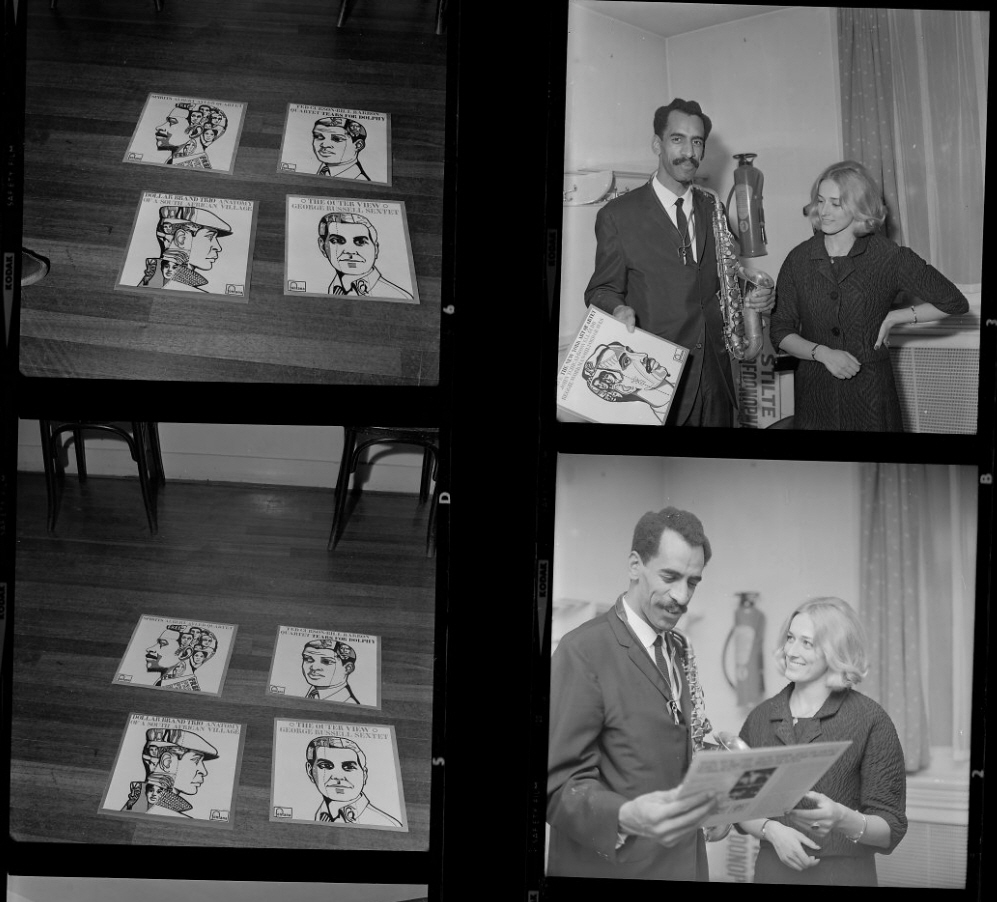 |
|
I’ve got a couple of those, The New York Art Quartet’s Mohawk and George Russell’s The Outer View, but the one which nobody has is Fontana 688 608 ZL, which is Albert Ayler’s Spirits (aka Witches and Devils), which was never released. The sleeve for that is the one in the top left on the table. Above is just a screen grab, so it’s best if you visit the Amsterdam City Archive page (file No. 37) to get the full picture. More examples of Marte Röling’s designs are available here. * Back to the L.S.E. The gift which just keeps on giving - Albert Ayler’s only British concert, destroyed by the BBC because it was not deemed fit for wives and servants to see. Last month I invoked the grassy knoll after Robin Kidson had revealed the lack of a paper trail for the concert in the extensive BBC archives. At which point, of course, Nicolas Pillai pops up on the Ayler facebook group with the following from his ‘Jazz on TV 1960-1969’ group: “The holy grail, of course, is the wiped Albert Ayler episode of Jazz Goes to College, filmed at the The London School of Economics and Political Science - LSE in 1966. The show’s presenter Humphrey Lyttelton described the night of recording as a prickly, uncomfortable event. A delay at the airport resulted in the musicians arriving late, the crowd were restive, there were technical hold-ups and Ronnie Scott heckled from the audience! A decision was taken not to broadcast (probably by Tom Sloan) and the recording was discarded. The concert took place on the evening of 15 November 1966 in the LSE Old Theatre, for an intended broadcast on 22 December 1966 (in the end, an Astrud Gilberto LSE date went out instead). The band line-up was: Albert Ayler (tenor sax), Donald Ayler (trumpet), Michael Sampson (violin), William Folwell (bass) and Beaver Harris (drums). Ayler devotees have read conspiracy into the decision to wipe so it would be nice to get to the bottom of it all. I'll ask producer Terry Henebery about it when I interview him later in the year. A few weeks ago, I was delighted to view the camera scripts for the episode at the BBC Archive, probably the only record of what was shot and how. Alongside a typewritten cover sheet, three handwritten pages sketch out shot breakdowns. The degree to which Ayler and his band were an unknown quantity may be discerned from a comparison to the Dave Brubeck script from a few weeks before, which runs to 22 pages. Here’s a vivid account on London Jazz from George Foster, who was present at the gig. Do note the comment at the end from Louis Barfe regarding the very important VT/telerecording issue, which (regrettably) I fudge somewhat in my book chapter on Jazz 625. http://www.londonjazznews.com/2016/11/feature-ghosts-and-spirits-remembering.html That article also draws upon contemporary reporting collated here: http://www.ayler.co.uk/html/concert2.html Crucially, the Ayler camera script also tells us the episode’s production team. Led by Terry Henebery, they were: Raquel Ebbutt (assistant), Duncan Anderson and John Elfes (engineering managers), Chris Holcombe (sound supervisor), Terry Learner (stage manager), John Reid (designer), Penny Delamar (makeup assistant) and Charlie Woolloff (sound supervisor). If you know of anybody mentioned above who might be available for interview, please do drop me a line. And if you happen to have a bootleg of the programme sitting in your attic don’t be shy. I’ll probably bite your arm off.” And then Nicolas added a second post: “A little more on that wiped Albert Ayler episode of Jazz Goes to College… A preliminary meeting was held on 25 October 1966 between BBC crew and university staff to establish ground rules for the Getz/Gilberto and Ayler recordings scheduled for 14 and 15 November. It was agreed that sound should be kept to a minimum up until 5.30pm and that no cables should be left trailing in corridors! It’s interesting to note that the LSE Chief Electrician was consulted and provided advice to the BBC lighting crew. The Students’ Union played an important role. David Adelstein, president of the SU (who would make international headlines when he led the protests of 1967), and Felicity Mate, administrative officer, acted as liaisons to the BBC. It was agreed that SU members would man the doors on the night and collect tickets. Admission was free but tickets had to be collected in advance from Union office S.102. Tickets and posters were printed up by the BBC. The LSE received £105.0.0 for the hiring of rooms and lighting, heating, cleaning etc. across both days – a separate invoice was required for the additional electricity used for telerecording but, since the LSE had facility for metering this, an estimate was provided by their Chief Electrician, Mr Frisby. Intriguingly, it does seem as though the Ayler programme was made on VT and that a telerecording was made. On the day, production crew had to clear out of the Old Theatre for a lecture – the plan had been then for a camera rehearsal between 3pm and 7pm, dinner 7pm-8pm and recording on VT 8.30pm and 10.30pm. But as we know from various accounts, things didn’t exactly go to plan! Four cameras were used: (1) a mobile eclair in the left-hand aisle which moved from the rear of the hall to close up to the stage, using turret lenses and a Varotal 5 zoom, (2) a mobile eclair in the right aisle with an Agineux zoom, (3) a rolling tripod in the circle working left to right, using another V5 zoom, and (4) a mobile eclair stage right with turret lenses (see the Getz link below to get a sense of how this might have looked). The programme would have begun with a still photograph of the LSE exterior in Houghton Street, taken by Hugh Tosh; this was a recurring feature of Jazz Goes to College, swiftly establishing whichever university they were visiting that week. Given how things turned out, it’s interesting to note that the BBC’s contract with LSE does provide for ‘abnormal circumstances’ – this is standard boilerplate but shows how a decision not to broadcast would have been framed institutionally. As I noted in my previous discussion of the camera scripts, it’s clear that there was some concern even before recording over the feasibility of an Ayler programme. The President of the LSE Jazz Society Len Smith had been recruited to drum up an audience from other university jazz clubs, a gambit which did seem successful. In a note written 22 November, series producer Terry Henebery asked David Adelstein if he would thank Smith for his efforts in filling the room. But a great deal is left unsaid when Henebery adds that the night had been ‘heavy-going’ for himself… and for the audience. Here’s Len Smith comparing Ayler to Jimi Hendrix, The Who, Ornette Coleman and The Electric Prunes as part of ‘a revolution in both pop and jazz music’:
|
|||||||||||||
|
Film News I think that’s it for last month, so here’s some film news. Tim Witham emailed to say he’d found Kasper Collin’s new documentary about Lee Morgan, I Called Him Morgan, on Netflix. So, if you have an account (or if, like me, you’re waiting till the new season of Stranger Things starts in October before signing up for a month) check it out. And Dirk Goedeking sent this link to a trailer for Patrice Chéreau’s 1983 film, L’Homme Blessé, which features Ayler’s ‘Heart Love’ on the soundtrack.
|
|||||||||||||
|
Two from the Magazines Pierre Crépon sent me a couple of scans from magazines. The first (which I will get round to transcribing) is John Norris’ ‘Three Notes with Albert Ayler’ from Coda (April./May 1966, pp. 9-11), which contains reviews of Ayler at the ‘Titans of the Tenor’ concert with John Coltrane at Lincoln Center, at the Astor Playhouse with his own group and an impromptu duet with Tony Scott at his club, The Dom. |
|||||||||||||
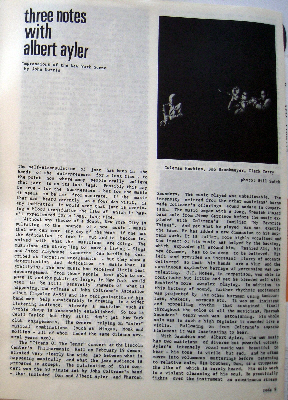 |
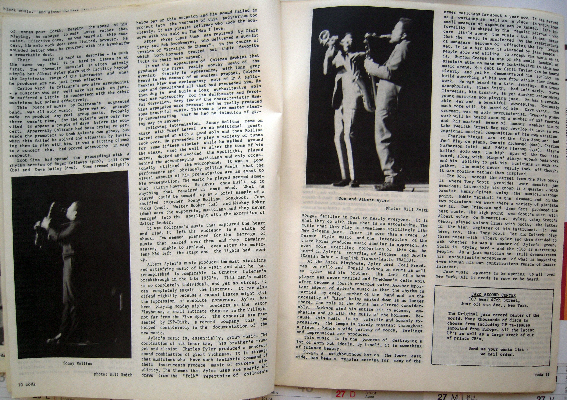 |
||||||||||||
|
The second item is the original version of the interview with Albert Ayler conducted by Daniel and Jacqueline Caux, published under the title, ‘My Name is... Albert Ayler’, in Chroniques de l’art vivant, (February 1971, pp. 24–25). In January 2003, The Wire published an English translation, which is available here. |
|||||||||||||
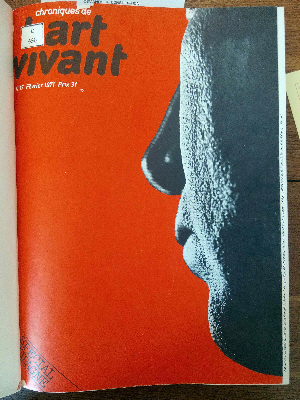 |
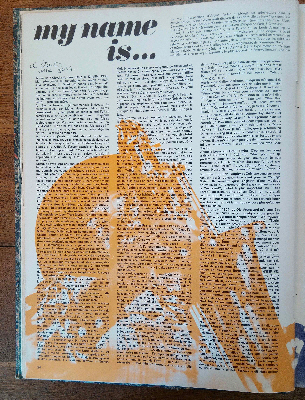 |
 |
|||||||||||
|
Spiritual Unity voted 30th best album of the 1960s Why is it always Spiritual Unity? Doesn’t anybody ever listen to Bells or In Greenwich Village? Apparently not, since the Pitchfork list of The 200 Best Albums of the 1960s only mentions Spiritual Unity, which is placed at No. 30. The highest ranking jazz album is A Love Supreme at No. 3. Anyway, this is a woman with Bells, and also, Reese and the Smooth Ones by the Art Ensemble of Chicago, which would definitely be in my Top 20 of 60s’ albums.
|
|||||||||||||
|
Albert Ayler comes top And while we’re on the subject of random lists, Albert Ayler comes out top of the ‘49 Cleveland-area celebrities you might have gone to high school with’ at cleveland.com - it’s alphabetical. * Two reviews There’s a review of the recent Hat Hut release, Copenhagen Live 1964 on the Chicago Reader site and on the popMATTERS site there’s this review of a new CD by the Chris Speed Trio which includes a version of Ayler’s ‘Spirits’. |
|||||||||||||
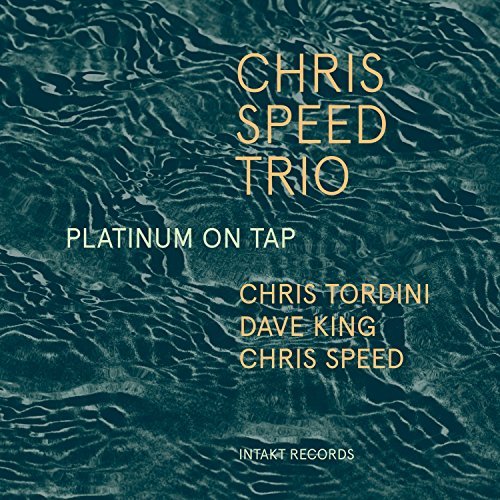 |
|||||||||||||
|
And finally ... The regular monthly version of ‘Ghosts’ on youtube - this one by Alex Bonney and Olie Brice on cornet and bass respectively. And this is John Stevens and the Spontaneous Music Ensemble from 1971.
|
|||||||||||||
|
*** News from 2004 (January - June) 2004 (July - December) 2005 (January - May) 2005 (June - December) 2010 (January - June) 2010 (July - December) 2011 (January - May) 2011 (June - September) 2011 (October - December) 2012 (January - May) 2012 (June - December) 2013 (January - June) 2013 (July - September) 2013 (October - December) 2014 (January - June) 2014 (July - December) 2015 (January - May) 2015 (June - August) 2015 (September - December) 2016 (January - March) 2016 (April - June) 2016 (July - August) 2016 (September - December) 2017 (January - May) 2017 (October - December) 2018 (January - May) 2018 (June - September) 2018 (October - December) 2019 (January - May) 2019 (June - September) 2019 (October - December) 2020 (January - April) 2020 (May - August) 2020 (September - December) 2021 (January - March) 2021 (April - July) 2021 (August - December) 2022 (January - April) 2022 (May - August) 2022 (September - December) 2023 (January - March) 2023 (April - June) 2023 (July - September) 2023 (October - December) 2024 (January - March) 2024 (April - June) 2024 (July - September) 2024 (October - December) 2025 (January - March)
|
|||||||||||||
|
Home Biography Discography The Music Archives Links What’s New Site Search
|
|||||||||||||

